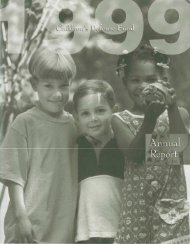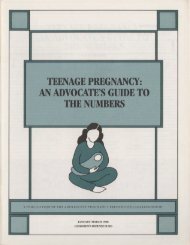child care - Digital Library Collections
child care - Digital Library Collections
child care - Digital Library Collections
You also want an ePaper? Increase the reach of your titles
YUMPU automatically turns print PDFs into web optimized ePapers that Google loves.
CHILDREN VIOLENCE, -'- AND CRIME<br />
-'--;.....;...;...;;. ---1<br />
ever, the number nearly doubled, so that in 1994 an<br />
average of 16 <strong>child</strong>ren were dying daily. The next<br />
year fmally brought a reversal to this deadly trend;<br />
in 1995 gun deaths dropped for the first time in 11<br />
years, to a still staggering 14 <strong>child</strong>ren dying each<br />
day from gunfIre. That meant that almost every<br />
100 minutes, on average, a bullet claimed the life of<br />
a <strong>child</strong>.<br />
As the explosion in crack cocaine traffIcking<br />
wreaked havoc in many urban communities, <strong>child</strong>ren<br />
increasingly reported a need to carry a gun<br />
for protection. They also found guns easier to obtain.<br />
Not surprisingly, gun murders by <strong>child</strong>ren<br />
rose sharply (until recently). Data from OJJDP<br />
show that between 1985 and 1994 such killings<br />
quadrupled, from more than 500 to more than<br />
2,000. Meanwhile, the number of murders by<br />
<strong>child</strong>ren without guns held steady at about 500<br />
annually.<br />
National response to this death toll has been<br />
minimal, and little has changed in our approach to<br />
regulating guns since 1973. According to a 1997<br />
U.S. Department of Justice study, there were<br />
nearly 200 million firearms in American homes in<br />
1994-almost one for every adult and <strong>child</strong>. The<br />
good news is that the overall percentage of homes<br />
with flfearms has declined slightly since the 1970s;<br />
it is now about 35 percent.<br />
Two measures-the 1993 Brady Act requiring<br />
waiting periods and criminal background checks<br />
for handgun purchasers, and the 1994 Assault<br />
Weapons Ban outlawing many nonsporting automatic<br />
weapons-have moved gun regulation in a<br />
commonsense direction. Unfortunately, many<br />
other national initiatives to keep <strong>child</strong>ren safe have<br />
not been enacted. These include bans on cheap,<br />
poorly made, nonsporting handguns popular with<br />
young people ("junk guns"); limits on the number<br />
of handgun purchases allowed in a given period<br />
("one handgun a month") in order to stop bulk<br />
purchasers who resell guns illegally to <strong>child</strong>ren;<br />
and requirements for <strong>child</strong> safety locks and other<br />
consumer protections. Although progress in gun<br />
safety has been made at the state and local levels<br />
(see later discussion), guns remain an enormous<br />
threat to <strong>child</strong>ren.<br />
Empty after-school hours. Another major<br />
change for <strong>child</strong>ren in the past 25 years is the<br />
amount of time they are left on their own, away<br />
from parents and other caring adults. According to<br />
the Bureau of Labor Statistics, in 1973 half of the<br />
mothers of school-age <strong>child</strong>ren were in the work<br />
force; today 77 percent are. More <strong>child</strong>ren now live<br />
in households where all the adults work outside the<br />
home. Many <strong>child</strong>ren spend less time with their<br />
parents and are often unsupervised for hours each<br />
day before their parents return from work. In total,<br />
nearly 5 million school-age <strong>child</strong>ren are left home<br />
alone each week.<br />
Some <strong>child</strong>ren are fortunate to have attentive<br />
<strong>care</strong>givers, after-school lessons or sports, extracurricular<br />
clubs, and other positive options to ml their<br />
out-of-school hours. Many use television and other<br />
media to fill the gap (see box 6.1). Others turn to<br />
riskier behavior: juvenile violent crime rates peak<br />
between 3 and 7 p.m. More positive opportunities<br />
for youth are needed to keep them safe and on<br />
track.<br />
Declines in Violence by and<br />
Against Children<br />
One ofthe most welcome pieces of news in 1997<br />
was the report that gun deaths of <strong>child</strong>ren had<br />
decreased in 1995. In that year, according to<br />
the National Center for Health Statistics, such<br />
deaths dropped for the flfst time in a decade, and<br />
by nearly 10 percent-from 5,820 the previous year<br />
to 5,277 (see table 6.1). Reductions in gun deaths<br />
among Black males (which had skyrocketed in recent<br />
years) drove the decline, falling more than 20<br />
percent. The National Center for Health Statistics<br />
also reported a lower incidence ofkillings ofyouths<br />
by all causes in 1995, building on a slight dip the<br />
previous year (see figure 6.1).<br />
Juvenile crime also decreased. New OJJDP<br />
data released in 1997 show that arrest rates of<br />
young people for violent crimes (murder, rape,<br />
robbery, aggravated assault) fell in 1996 for the<br />
second year in a row-a total drop of more than 12<br />
percent (see fIgure 6.2). Juvenile homicide arrest<br />
rates dropped for the third straight year since<br />
CHI L D R E 'S D E F ESE FUN D 79














